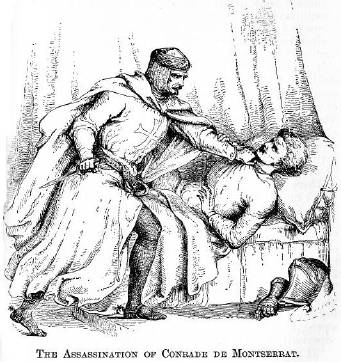

Walter Scott, The Talisman, Ivanhoe
The 'Wizard of the North' has a lot to answer for. Besides his tartanised pseudo-Highland vision of Scotland - epitomised by George IV's visit to Edinburgh and culminating in the travesty that was Braveheart - his vision of the 12C is odd.
Notwithstanding the fact that it was The Talisman that got me interested in this time period as a teenager, Scott used it to savage the reputation of one of the most courageous and impressive characters of the era. The appalling misrepresentation of Conrad de Montferrat in later English-language writing can be traced back to Scott (who can't even spell his name correctly, confusing the 'f' with a long 's'!). He openly admitted in his 1832 introduction:
Considerable liberties have also been taken with the truth of history, both with respect to Conrade of Montserrat’s [sic] life, as well as his death. That Conrade, however, was reckoned the enemy of Richard, is agreed both in history and romance. The general opinion of the terms upon which they stood, may be guessed from the proposal of the Saracens, that the Marquis of Montserrat should be invested with certain parts of Syria, which they were to yield to the Christians. Richard, according to the romance which bears his name, ‘could not longer repress his fury. The Marquis, he said, was a traitor, who had robbed the Knight Hospitallers of sixty thousand pounds, the present of his father, Henry; that he was a renegade, whose treachery had occasioned the loss of Acre; and he concluded by a solemn oath, that he would cause him to be drawn to pieces by wild horses, if he should ever venture to pollute the Christian camp by his presence[…]’ - History of Chivalry.
Conrade of Montserrat makes a considerable figure in those wars, and was at length put to death by one of the followers of the Scheik, or Old Man of the Mountains; nor did Richard remain free of the suspicion of having instigated his death.
 For Scott, the mere fact that Conrad was on bad terms with Richard was sufficient reason to charge him with any calumny and treachery. So he depicts him as a Gothic-novel 'scheming Italian' stereotyped villain - a dandy, a coward on the battlefield, treacherous and unprincipled. Scott has him plotting with the Grand Master of the Templars (a fictional one, Giles Amaury, not the real Gerard de Ridefort) against Richard, and getting a lance in his chest in a trial-by-combat with the typically wet hero, Sir Kenneth (aka David, Earl of Huntingdon). As if this isn't bad enough, while recovering in bed, he is stabbed to death by Amaury lest he reveal their conspiracy in confession. The hero, incidentally, besides being a Scottish prince pretending to be a knight, also spends part of the story blacked up, pretending to be a Nubian... And Saladin disguises himself as a doctor and patches up everyone in the story, from Richard to Conrad, as a sort of one-man National Health Service. (Was Scott on laudanum at this time? It might explain a lot...!)
For Scott, the mere fact that Conrad was on bad terms with Richard was sufficient reason to charge him with any calumny and treachery. So he depicts him as a Gothic-novel 'scheming Italian' stereotyped villain - a dandy, a coward on the battlefield, treacherous and unprincipled. Scott has him plotting with the Grand Master of the Templars (a fictional one, Giles Amaury, not the real Gerard de Ridefort) against Richard, and getting a lance in his chest in a trial-by-combat with the typically wet hero, Sir Kenneth (aka David, Earl of Huntingdon). As if this isn't bad enough, while recovering in bed, he is stabbed to death by Amaury lest he reveal their conspiracy in confession. The hero, incidentally, besides being a Scottish prince pretending to be a knight, also spends part of the story blacked up, pretending to be a Nubian... And Saladin disguises himself as a doctor and patches up everyone in the story, from Richard to Conrad, as a sort of one-man National Health Service. (Was Scott on laudanum at this time? It might explain a lot...!)
Scott really has it in for the Templars, in both The Talisman and Ivanhoe: a combination of anti-Occultism (not that the Templars were Occult at all - but their history was hijacked in the late 18C by Occultists and Freemasons) and anti-Catholicism (since they were the armed wing of the Cistercians) is at the root of it. (Scott's mediæval heroes are essentially early 19C Scottish Episcopalian gentlemen in fancy dress.) Ivanhoe also adds some very bizarre ingredients such as Normans vs Saxons in the 1190s (that's so 11C!), and Robin Hood, who properly belongs to the 14C. It also seems to have escaped his notice that the tormented relationship between Brian and Rebecca is a thousand times more interesting than the insipid Wilf/Rowena pairing...
Back to
TOP

